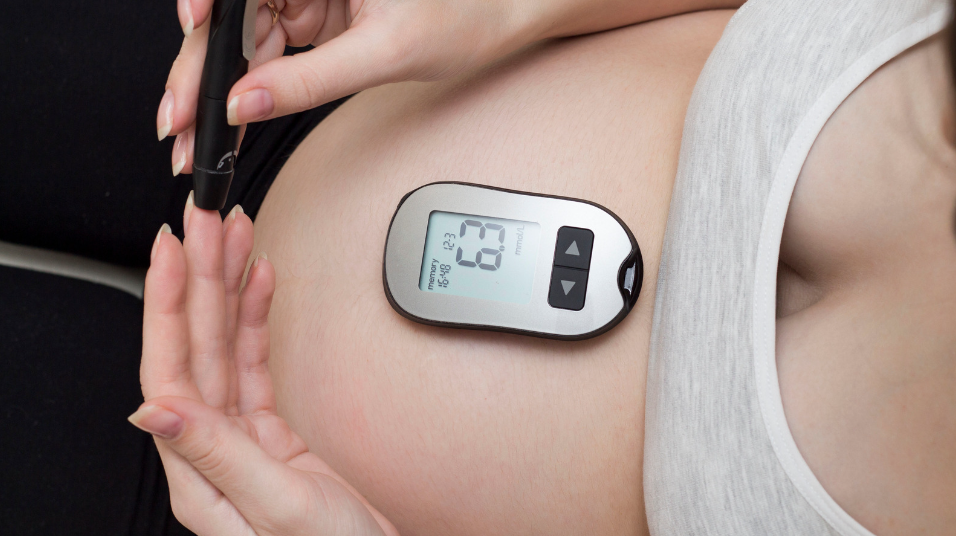Gestational diabetes – What is it, how are we testing for it and are these tests accurate?
Before we look at the ins and outs of gestational diabetes, let’s first examine what happens in a non pregnant body when diabetes occurs.
When we consume carbohydrates and sugars, enzymes play a crucial role in breaking down the food into simple sugars. Some of these sugars are digested and immediately utilised for energy, while others are stored for later use. The primary sugar, glucose, enters the tissue cells and combines with oxygen, resulting in the production of carbon dioxide and water. The energy released from this chemical reaction is essential for various bodily functions, including muscular work and maintaining body temperature. Insulin, a hormone produced by the pancreas, facilitates the transport of glucose across cell walls.
Diabetes is often simplistically associated with a lack of insulin, but according to Foster in Harrison’s Principles of Internal Medicine, the term diabetes encompasses various syndromes. One of these syndromes is diabetes mellitus, characterised by symptoms such as sugar in the urine, excessive thirst, frequent urination, increased food intake, and elevated blood sugar levels. Diabetes mellitus is typically diagnosed based on persistent high fasting plasma glucose levels.
The symptoms of diabetes mellitus are linked to three main physiological conditions: lack of insulin, elevated glucose production, or insulin resistance. Each of these conditions can have multiple underlying causes. A deficiency of insulin may result from viral infections or a diet rich in unsaturated fatty acids, low in magnesium, and vitamin B-6, which can damage the pancreas and reduce insulin secretion.
Hyperglycemia, or elevated blood sugar levels, can be triggered by infections or the presence of epinephrine (adrenaline), estrogen, or steroids in the bloodstream. Stress from infections can lead to the secretion of epinephrine and cortisol, causing the liver to break down glycogen, increasing blood sugar levels. Hormones like estrogen, progesterone, and lactogen can also counteract the action of insulin and raise blood sugar. Steroids, on the other hand, stimulate the liver to produce more glucose from proteins and fats.
Insulin resistance, the third condition, can be caused by factors like obesity, physical inactivity, or inadequate carbohydrate intake. Obesity reduces the number of insulin receptors, which are necessary for insulin transport across cell walls. Physical inactivity or insufficient carbohydrate intake can lead to decreased carbohydrate tolerance and subsequent insulin resistance. In rare cases, unusual types of insulin secretion can also cause insulin resistance.
Genetic factors can also play a role in predisposing individuals to diabetes in response to the aforementioned influences. In such cases, as well as in some of the scenarios mentioned above, individuals with normal test results may be considered potential diabetics due to lifestyle, physical history, or family history.
In “gestational diabetes,” however, a pregnant woman shows test results similar to non-pregnant individuals with diabetes, despite having no symptoms of diabetes. It is important to note that this type of “diabetes” ceases after the pregnancy ends. However, clinical diabetes that is diagnosed during pregnancy and persists beyond the gestational period should not be classified as “gestational diabetes”.
Some practitioners question the existence of “gestational diabetes” because it is often diagnosed solely based on test responses. A non-symptomatic mother might exhibit elevated blood sugar levels due to various factors. For instance, the test itself, involving fasting followed by consuming concentrated glucose, may trigger chemical changes in her body that lead to increased blood sugar. Alternatively, her body may be responding naturally to the dynamics of pregnancy.
During pregnancy, blood sugar elevations can result from various factors. Additionally, the placenta releases hormones like lactogen, estrogen, and progesterone, which counteract the function of insulin and powerful enzymes that can destroy insulin. One might wonder if the placenta, an organ designed to sustain pregnancy and support the baby’s growth for nine months, consistently makes such an “error.”
It is crucial to understand that the pregnant body handles glucose differently. During pregnancy, the body may require “hyperglycemia” or higher blood sugar levels. This ensures that glucose remains in the bloodstream for longer periods, providing an easily available energy source for the developing baby’s growth and fat storage, in addition to being converted into glycogen and stored in the liver for future use.
Research by Tom Brewer, MD, indicates that well-nourished pregnant women can maintain stable plasma glucose levels and sufficient glycogen stores in the liver. On the other hand, poorly or marginally nourished women may have minimal or nonexistent glycogen stores, resulting in a decline in plasma glucose levels shortly after eating, until the next meal.
Another normal occurrence during pregnancy is a lowered renal threshold for glucose and other sugars. The kidneys filter a significant amount of filtrate from the blood daily, but during pregnancy, the renal threshold for sugar changes, leading to glucose being excreted in the urine at lower blood plasma levels.
This lowered renal threshold for glucose serves a purpose during pregnancy. When a woman is eating well, her blood volume increases significantly, resulting in increased blood flow through the kidneys and higher rates of fluid passing through capillary walls in the kidneys. As a consequence, certain substances may not get reabsorbed as efficiently as in non-pregnancy. For example, glucose may show up in the urine during pregnancy even though blood glucose levels are normal.
Discovering sugar in the urine during a prenatal visit does not necessarily indicate unhealthy plasma glucose levels. Approximately one-sixth of all pregnant women spill glucose in their urine, and glucose in the urine is present in 50 percent of all normal pregnancies, according to William’s Obstetrics and Evelyn Burns’ report on “Diabetes Mellitus and Pregnancy.”
Testing for GDM
When assessing glycosuria (the presence of glucose in the urine) during pregnancy, birth practitioners may opt for prenatal testing to rule out clinical diabetes or other concerning symptoms. Common testing options include the fasting blood sugar test, the one-hour glucose test, the two-hour postprandial blood sugar test, the random blood sugar test, the hemoglobin A1C test, and the glucose tolerance test (GTT). Some practitioners consider the two-hour postprandial and random blood sugar tests non standardised and prefer not to use them.
The fasting blood sugar test involves an eight- to 12-hour fast, followed by a blood sample to determine fasting blood sugar levels. The normal values vary depending on the practitioner’s philosophy.
For the one-hour glucose test, an eight- to 12-hour fast is followed by a preliminary blood sample. The mother is then given a “glucola” drink containing 50 grams of glucose, and another blood sample is taken after one hour. The upper limit of normalcy increases with age and during pregnancy.
An alternative approach to the one-hour glucose test, described in the winter 1987 issue of Midwifery Today, involves conducting the test at 24 to 28 weeks gestation without fasting. A value of 140 mg/100 ml or higher suggests “gestational diabetes.”
The long fasting period required by standardised tests can be problematic. Even well-nourished pregnant women can deplete their liver glycogen stores after 12 hours of fasting, leading to nausea. Pregnant women ideally should eat something every two to three hours.
The two-hour postprandial test requires blood sampling two hours after a meal. Normal test values range from <120 mg/100 ml to <140 mg/100 ml. Eating a generous breakfast is recommended instead of using glucola.
The random blood sugar test involves evaluating blood drawn at a random time of day, without fasting. Normal values range from about 100 mg/100 ml to 110 mg/100 ml.
The hemoglobin A1C test does not require fasting and provides an analysis of glucose levels over the previous 120 days. It is not influenced by recent food intake. Normal values range from 4 to 7 percent of total hemoglobin.
The glucose tolerance test (GTT) is considered the most definitive test for assessing glucose management. It requires an eight- to 12-hour fast, and multiple blood and urine samples are taken at different intervals after drinking concentrated glucose. However, the GTT has several drawbacks, including its accuracy being influenced by factors like diet, stress, and exercise.
The accuracy of the GTT has been questioned, with positive results being accurate only 25 percent of the time. Additionally, changes in glucose level standards have led to the potential misdiagnosis of “gestational diabetes” in well-nourished women with normal plasma glucose levels.
Overall, prenatal diabetic evaluation may not be entirely reliable, and there are limitations to the accuracy of certain testing methods.





